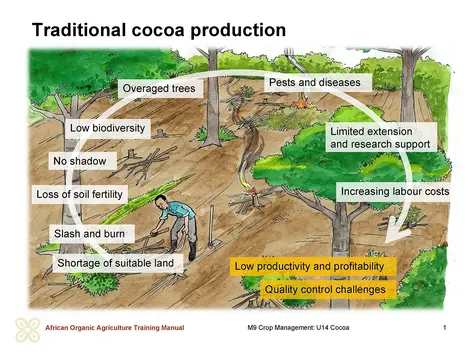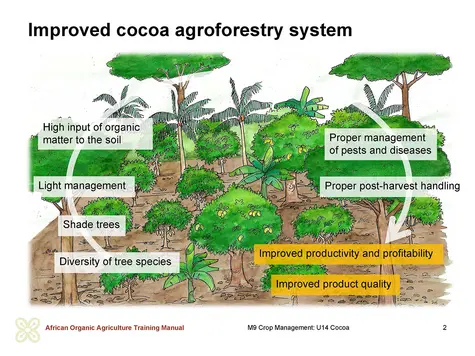Introduction
Cocoa (Theobroma cacao) plantations are one of the most important forms of land use and are of enormous economic importance to developing countries in the humid tropics. The main cocoa producing countries in Africa include Cameroon, Ivory Coast, Ghana and Nigeria in West Africa. However, organic cocoa is mainly produced in Madagascar, Tanzania and Uganda. FAO reports that the world dry cocoa bean production has increased in the last 30 years from 1.54 to 4.16 million tonnes. To reach this total production, the world average yields in dry beans have increased from 350 kg per hectare to 500 kg per hectare during that time and the area under cocoa was substantially increased. However, the International Cocoa Organisation reports that there are big differences in yields between regions. While farmers in West Africa attain yields of 200 to 300 kg per hectare, farmers in Latin America and Indonesia harvest between 500 and 600 kg of cocoa beans per hectare on average.
Assessment of the local cocoa production practices
In order to gain a better understanding of the main characteristics of the cocoa farming system in the area, ask the following guiding questions to the farmers:
- What are the main characteristics of a cocoa plantation?
- What kind of crops are grown with cocoa and how?
- What are the challenges facing cocoa production in the area? Are there opportunities for increasing cocoa production?
At the end of the session, you should be able to identify potentials and constraints for improving productivity and quality of cocoa.
Common challenges facing cocoa production in Africa
Limited extension and research support - Most cocoa in Africa is grown by small scale farmers, who are mostly relying on traditional production practices. There is limited or non-existent extension support, and improved production technologies often do not reach the farmers.
Shortage of suitable land for expansion of cocoa production - Traditionally, primary forests, which have fertile soils and give a conducive forest environment for cocoa production, were often cut through the practice of slash and burn. Since forest land is no longer available as in the past, new cocoa plantations must be established on agricultural land. Additionally, laws and regulations limit access to natural resources in some countries. In some countries governments own all primary forests with timber trees. As a result, farmers are not motivated to protect them or to establish timber trees in their gardens since the land is not theirs.
Low productivity and profitability of cocoa plantations - Many cocoa plantations in Africa are poorly managed and trees are overaged. In some cases, cocoa is grown in monocultures under largely unshaded conditions. Such a production system enhances loss of soil fertility and biodiversity. Poor soil fertility has led to poor growth and premature aging of the cocoa trees, and hence to low productivity. Unfavourable climate changes through irregular rainfall patterns and droughts have also contributed to increased stress for cocoa trees rendering the cocoa trees more susceptible to pest and diseases.
Most cocoa farmers are experiencing low farm gate prices for their produce. Yet all input prices such as labour costs are increasing. There are increasing industry concerns about using child labour as a cheap source of labour.
Quality control challenges - because of many factors including pest and disease damage, poor postharvest handling and limited processing infrastructure, the majority of the produced cocoa is of poor quality.
The diversification of cocoa plantations and the production of high quality cocoa beans are important strategies in order to improve the economic and social situation surrounding cocoa production.
The most important intervention today is to improve production of the existing cocoa plantations in order to minimize the continuous search for fertile soils in primary forests. This requires implementation of more diversified agroeco-systems that satisfy the ecological requirements of the cocoa trees. Increased yields have been reported in organic cocoa cultivation, where a sustainable multistorey agroforestry system was properly established and is well managed. Additionally, a system based on high diversity holds enormous potential for environmental conservation in cocoa producing regions.
Discussion on establishing a cocoa plantation
Engage the farmers into a discussion in order to identify, what they normally consider when they are establishing a cocoa plantation, by asking the following questions:
- What are most suitable conditions for producing cocoa?
- What kind of site is conducive to growing cocoa trees?
- What kind of varieties do you grow? Are there any preferred varieties, which are most suited for the local conditions?
- How do you prepare seedlings for planting?
- How is planting done?
Record all the contributions and make reference to them, as you present the recommendations in this section.


 tap and then scroll down to the Add to Home Screen command.
tap and then scroll down to the Add to Home Screen command.